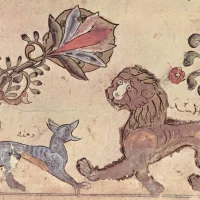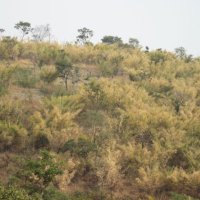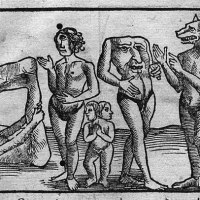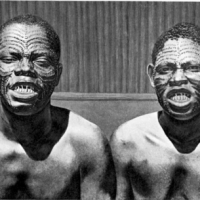Following on the last blog, about indigenous coffee in Uganda – and about other indigenous crops, here follows some passages from 19th Century explorers on ‘coffee culture’ and the agriculture of indigenous coffee in east Africa and the Sudan.
The importance of coffee in the highlands of central and east Africa was both to enjoy (preferably with pombe beer) and also was part of specific greeting and social ceremonies – both among local folk as well as with Arab merchants who traded in these areas. The coffee was never made into a drink by local people, but was chewed. It formed an important trade item that was sold by cultivators to or directly to Arab and Swahili merchants coming from the coast of East Africa, from where it would have been shipped in the Middle East or India.
I was amazed a couple of years ago, in an area of north-central Burundi where I was conducting a series of livestock training activities, to find in the main little market town about half a dozen ruined buildings. Locals said that these had belonged to Arabs [i.e., from the Swahili population in the country], who had settled in this village in order to purchase coffee from local people and also to help in its planting. The coffee that they purchased was – as in the 19th Century – shipped through Tanzania to the east African coast for sale elsewhere. This Swahili/Arab community was abandoned in the early 1990’s, with the war of that period.

Ruined buildings of former Arab merchants in a coffee-producing region of upland Burundi are in the background
The continuity of the Arab-indigenous links with coffee production and sales into the 21st century I found fascinating.
Some information on coffee culture and agriculture from the 19th Century:
…imports from the northern countries along the western margin of the N’yanza Lake [i.e., the left side of Lake Victoria], a small wild coffee, locally called mwaml Like all wild productions, it is stunted and undeveloped, and the bean, which, when perfect, is about the size of a ooridng-pin’s head, is never drunk in ecoction.
The berry, gathered unripe, is thrown into hot water to defend it from rot, or to prevent its drying too rapidly, an operation which converts the husk to a dark cnocolate color: the people of this country chew it like tobacco, and, during visits, a handful is invariably presented to the guest
According to the Arabs, it has, like the idshr of Yemen, stimulating properties, affects the head, prevents somnolency, renders water sweet to the taste, and forms a pleasant refreshing beverage, which the palate, however, never confounds with the teste of the Mocha berry.
In Karagwah a single khete of beads purchases a kubabah (from 1 lb. to 2 lbs.) of this coffee; at Kazeh* and Msene, where it is sometimes brought by caravans, it sells at fency prices…
* [Arab/Swahili market settlement in central Tanzania, on the main caravan route from the coast inland.]

Warehouse of one of the Arab Merchants at Kaze, central Tanzania, ca. 1865. Source: Speke-The Discovery of the Source of the Nile
The tributary ‘Wahajrya’, under Gaetawa, their sultan, still extend to the eastward. North of the Wahayya, of whose territory little is known, lies ” Kittara,*” in Kinjroro (or Kiganda?), a word interpreted to mean “mart” or ” meetingplace.” This is the region which supplies Karagwah with coffee.
The shrub is propagated by sowing the bean. It attains the height of five feet, branching out about half way; it gives fruit after the third, and is in full vigor after the fifth year. Before almost every hut-door there is a plantation, forming an effective feature in the landscape of rolling and wavy hill, intersected by a net-work of rivers and streams : the foliage is compared to a green tapestry veiling the ground ; and at times, when the leaves are stripped off by wind and rain, the plant appears decked with brilliant crimson cherrv-like berries.
* Kitara – ‘a well-known coffee mart’
Source: Richard Burton – The Lake Regions of Central Africa, A Picture of Exploration. 1860
==============
In the earliest times the Wahuma of Unyoro regarded all their lands bordering on the Victoria Lake as their garden, owing to its exceeding fertility, and imposed the epithet of Wiru, or slaves, upon its people, because they had to supply the imperial government with food and clothing. Coffee was conveyed to the capital by the Wiru, also mbugu (bark-cloaks), from an inexhaustible fig-tree; in short, the lands of the Wiru were famous for their rich productions….
On arrival there at the government establishment [a village in Uganda]–a large collection of grass huts, separated one from the other within large enclosures, which overspread the whole top of a low hill–I was requested to withdraw and put up in some huts a short distance off, and wait until his excellency, who was from home, could come and see me; which the next day he did, coming in state with a large number of officers, who brought with them a cow, sundry pots of pombe [local beer], enormous sticks of sugar-cane, and a large bundle of country coffee. This grows in great profusion all over this land in large bushy trees, the berries sticking on the branches like clusters of hollyberries.,,
…Before breakfast I called on poor Usungu, prescribing hot coffee to be drunk with milk every morning, which astonished him not a little, as the negroes only use coffee for chewing…
No food, however, was given to my men, though the king, anticipating Bombay’s coming, sent me one load of tobacco, one of butter, and one of coffee. My residence in Uganda became much more merry now, for all the women of the camp came daily to call on my two little girls; during which time they smoked my tobacco, chewed my coffee, drank my pombe, and used to amuse me with queer stories of their native land…
…Kamrasi* sent me four parcels of coffee, very neatly enclosed in rush pith.
* Kamrasi was king of Unyoro, a small, northern kingdom in what is today Uganda.
Source: John Hanning Speke – The Discovery of The Source of the Nile. 1863
===============
Kanoni led us into his boma, and treated us with sour curd. Then, at my request, he assembled his principal men and greatest travellers to debate upon the N’yanza [Lake Victoria]. One old man, shrivelled by age, stated that he had travelled up the western shores of the N’yanza two moons (sixty days) consecutively, had passed beyond Karagué into a country where coffee grows abundantly, and is called Muanyé.
He described the shrub as standing between two and three feet high, having the stem nearly naked, but much branched above; it grows in large plantations, and forms the principal article of food. The people do not boil and drink it as we do, but eat the berry raw, with its husk on.
The Arabs are very fond of eating these berries raw, and have often given us some. They bring them down from Uganda, where, for a pennyworth of beads, a man can have his fill.
When near these coffee plantations, he (our informer) visited an island on the lake, called Kitiri, occupied by the Watiri, a naked lot of beings, who subsist almost entirely on fish and coffee…
Source: John Hanning Speke – What Led To The Discovery of the Source Of The Nile. 1864
===============
In Unyoro, a kingdom in Uganda to the left of Lake Victoria:
…Yesterday the natives brought coffee in small quantities to sell. They have no idea of using it as a drink, but simply chew it raw as a stimulant. It is a small and finely-shaped grain, with a good flavour. It is brought from the country of Utumbi, about a degree south of this spot…
…large sugarcanes of the blue variety were growing in the fields, and I had seen coffee growing wild in the forest in the vicinity.
…Not only were the natives clever generally in their ideas, but they were exceedingly cunning in their bargains. Every morning, shortly after sunrise, men might be heard crying their wares throughout the camp–such as, “Tobacco, tobacco; two packets going for either beads or simbis!” (cowrie-shells). “Milk to sell for beads or salt!” “Salt to exchange for lance-heads!” “Coffee, coffee, going cheap for red beads!” “Butter for five jenettos (red beads – these were given to me by Speke at Gondokoro)* a lump!”
* Gondokoro is located just before the border between current Southern Sudan and Uganda, and today is called Juba. When Speke finally left Uganda and proceeded down the White Nile, he met Baker at Gondokoro. Baker was on his way up the White Nile to the area of northern Uganda.
Source: Samuel W. Baker – The Albert N’Yanza, Great Basin of the Nile,
===============
I received a very polite message from Mek Nimmur*, accompanied by a present of twenty pounds of coffee, with an invitation to pay him a visit. His country lay between the Settite river and the Bahr Salaam; thus without his invitation I might have found it difficult to traverse his territory;–so far, all went well. I returned my salaams, and sent word that we intended to hunt through the Base country, after which we should have the honour of passing a few days with him on our road to the river Salaam, at which place we intended to hunt elephants and rhinoceros…
…The principal trade of Gallabat**which is the market-place for all commerce between Abyssinia and the Egyptian provinces, is in cotton, coffee, bees’-wax, and hides. Coffee is brought in large quantities by the Abyssinian merchants, who buy cotton in exchange, for the manufacture of clothes according to their own fashion. I bought a quantity of excellent coffee at the rate of two dollars for thirty-five pounds, equal to about two and three-quarters pence a pound.
* Mek Nimmur was a ruler in the mountains just beyond Sudan in Ethiopia who raided extensively into Sudanese lands.
** Gallabat A major market town in SE Sudan.
Source: Samuel W.Baker – The Nile Tributaries of Abyssinia…1861-2
================
…Coffee is drunk only by the merchants and the very first people, and even by them it is not in daily use. The coffee is not the Arabian or Mokha coffee, but that which grows wild in the southwestern mountains of Abyssinia, from whence it is imported by the Sennaar merchants. It is sold thirty per cent. cheaper than the Mokha coffee in Egypt, but its shape and taste appear to be the same.
…Sennaar: Coffee-beans, in small quantity, the growth of Abyssinia and the Gala country. None of these are carried from Massouah to Djidda, as the coffee plant grows in the most western parts of Abyssinia only. Coffee is not commonly drunk here; it is a luxury in which the chiefs alone indulge.
Source: John Lewis Burckhardt – Travels in Nubia: Description of a Journey from Upper Egypt through the Deserts of Nubia to Berber and Suakin, and from thence to Djidda in Arabia. Performed in the Year 1814. (Ch.2)
Today, in the market towns and amongst the nomadic groups of eastern Sudan and Egypt, coffee continues as an important beverage by which to entertain visitors, initiate discussions of a social or political nature, and otherwise just to enjoy. On coffee rituals of the Beja [Bishareen] tribes of S.E. Egypt and N.E. Sudan, see this blog.

The exact same type of cup is still used throughout Eastern Sudan and Egypt for coffee. Source-unknown, in my computer many years – but think the origin is Turkish (?)

Egyptian coffee service with similar cup. Source: Lane-Manners and Customs of the Modern Egyptians, c.1830
Related articles
- NEW – Burundi AA Kirirmiro Coffee! (coffeeam.wordpress.com)






![Baking Holy Bread in the Coptic Monasteries of the Eastern Desert of Egypt [qurban; 'urban]](https://dianabuja.files.wordpress.com/2015/02/one-whittemore_s-expedition-before-leaving-the-monastery-of-saint-anthony-egypt-1930-19312.png?w=200&h=200&crop=1)


















